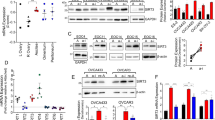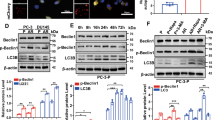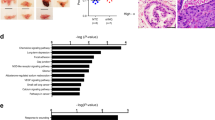Abstract
Resistance to detachment-induced apoptosis, a process commonly referred as anoikis, is emerging as a hallmark of metastatic malignancies, mainly because it can ensure anchorage-independent growth and survival during organ colonization. Besides, a sustained oxidative stress has been associated with several steps of carcinogenesis, including transformation and achievement of a motile mesenchymal phenotype. Here, we demonstrate that metastatic prostate carcinoma cells, undergoing a constitutive deregulated production of reactive oxygen species due to sustained activation of 5-lipoxygenase, lack suicidal pathways in response to lack of matrix contact. These amplified and persistent redox signals in PC3 cells leads to maintenance of Src oxidation and activation in the absence of adhesion, thereby sustaining a ligand-independent phosphorylation of epidermal growth factor receptor. This leads to chronic activation of pro-survival signals, culminating in degradation of the pro-apoptotic protein Bim, thereby promoting cell survival even in the absence of proper adhesion. Anoikis sensitivity of metastatic cells is restored with antioxidant intervention or genetic manipulation of the redox-mediated pro-survival pathway, as well as exposure to a pro-oxidant environment strongly increases anoikis resistance in non-transformed prostate epithelial cells. Hence, our results allow new insight into the aetiology of the molecular mechanisms granting anoikis resistance of metastatic cancers, opening new avenues to pharmacological intervention for antioxidant-sensitive invasive tumours.
This is a preview of subscription content, access via your institution
Access options
Subscribe to this journal
Receive 50 print issues and online access
$259.00 per year
only $5.18 per issue
Buy this article
- Purchase on Springer Link
- Instant access to full article PDF
Prices may be subject to local taxes which are calculated during checkout









Similar content being viewed by others
Abbreviations
- AA861:
-
2-(12-hydroxydodeca-5,10-diynyl)-3,5,6-trimethyl-1,4-benzoquinone
- DCF-DA:
-
2′,7′-dichlorofluorescein diacetate
- ECM:
-
extracellular matrix
- EGFR:
-
epidermal growth factor receptor
- ERKs:
-
extracellular signal-regulated protein kinases
- 5-LOX:
-
5-Lipoxygenase
- NAC:
-
N-acetyl cisteine
- PI:
-
propidium iodide
- PI3K:
-
phosphatidylinositol 3-kinase
- ROS:
-
reactive oxygen species
References
Bouillet P, Strasser A . (2002). BH3-only proteins—evolutionarily conserved proapoptotic Bcl-2 family members essential for initiating programmed cell death. J Cell Sci 115: 1567–1574.
Cabodi S, Moro L, Bergatto E, Boeri EE, Di Stefano P, Turco E et al. (2004). Integrin regulation of epidermal growth factor (EGF) receptor and of EGF-dependent responses. Biochem Soc Trans 32: 438–442.
Cannito S, Novo E, Compagnone A, Valfre dB, Busletta C, Zamara E et al. (2008). Redox mechanisms switch on hypoxia-dependent epithelial-mesenchymal transition in cancer cells. Carcinogenesis 29: 2267–2278.
Chambers AF, Groom AC, MacDonald IC . (2002). Dissemination and growth of cancer cells in metastatic sites. Nat Rev Cancer 2: 563–572.
Chang YM, Bai L, Liu S, Yang JC, Kung HJ, Evans CP . (2008). Src family kinase oncogenic potential and pathways in prostate cancer as revealed by AZD0530. Oncogene 27: 6365–6375.
Chiarugi P, Fiaschi T . (2007). Redox signalling in anchorage-dependent cell growth. Cell Signal 19: 672–682.
Chiarugi P, Pani G, Giannoni E, Taddei L, Colavitti R, Raugei G et al. (2003). Reactive oxygen species as essential mediators of cell adhesion: the oxidative inhibition of a FAK tyrosine phosphatase is required for cell adhesion. J Cell Biol 161: 933–944.
Clerkin JS, Naughton R, Quiney C, Cotter TG . (2008). Mechanisms of ROS modulated cell survival during carcinogenesis. Cancer Lett 266: 30–36.
Comoglio PM, Boccaccio C, Trusolino L . (2003). Interactions between growth factor receptors and adhesion molecules: breaking the rules. Curr Opin Cell Biol 15: 565–571.
Diaz-Montero CM, Wygant JN, McIntyre BW . (2006). PI3-K/Akt-mediated anoikis resistance of human osteosarcoma cells requires Src activation. Eur J Cancer 42: 1491–1500.
Federico A, Morgillo F, Tuccillo C, Ciardiello F, Loguercio C . (2007). Chronic inflammation and oxidative stress in human carcinogenesis. Int J Cancer 121: 2381–2386.
Frisch SM, Screaton RA . (2001). Anoikis mechanisms. Curr Opin Cell Biol 13: 555–562.
Giannoni E, Buricchi F, Grimaldi G, Parri M, Cialdai F, Taddei ML et al. (2008). Redox regulation of anoikis: reactive oxygen species as essential mediators of cell survival. Cell Death Differ 15: 867–878.
Giannoni E, Buricchi F, Raugei G, Ramponi G, Chiarugi P . (2005). Intracellular reactive oxygen species activate Src tyrosine kinase during cell adhesion and anchorage-dependent cell growth. Mol Cell Biol 25: 6391–6403.
Goldenberg-Furmanov M, Stein I, Pikarsky E, Rubin H, Kasem S, Wygoda M et al. (2004). Lyn is a target gene for prostate cancer: sequence-based inhibition induces regression of human tumor xenografts. Cancer Res 64: 1058–1066.
Haklar G, Sayin-Ozveri E, Yuksel M, Aktan AO, Yalcin AS . (2001). Different kinds of reactive oxygen and nitrogen species were detected in colon and breast tumors. Cancer Lett 165: 219–224.
Irani K, Goldschmidt-Clermont PJ . (1998). Ras, superoxide and signal transduction. Biochem Pharmacol 55: 1339–1346.
Kairouz-Wahbe R, Biliran H, Luo X, Khor I, Wankell M, Besch-Williford C et al. (2008). Anoikis effector Bit1 negatively regulates Erk activity. Proc Natl Acad Sci USA 105: 1528–1532.
Kopfstein L, Christofori G . (2006). Metastasis: cell-autonomous mechanisms versus contributions by the tumor microenvironment. Cell Mol Life Sci 63: 449–468.
Le Gall M, Chambard JC, Breittmayer JP, Grall D, Pouyssegur J, Obberghen-Schilling E . (2000). The p42/p44 MAP kinase pathway prevents apoptosis induced by anchorage and serum removal. Mol Biol Cell 11: 1103–1112.
Ley R, Ewings KE, Hadfield K, Cook SJ . (2005). Regulatory phosphorylation of Bim: sorting out the ERK from the JNK. Cell Death Differ 12: 1008–1014.
Loza-Coll MA, Perera S, Shi W, Filmus J . (2005). A transient increase in the activity of Src-family kinases induced by cell detachment delays anoikis of intestinal epithelial cells. Oncogene 24: 1727–1737.
Mallozzi C, Di Stasi MA, Minetti M . (2001). Peroxynitrite-dependent activation of src tyrosine kinases lyn and hck in erythrocytes is under mechanistically different pathways of redox control. Free Radic Biol Med 30: 1108–1117.
Martinez-Sanchez G, Giuliani A . (2007). Cellular redox status regulates hypoxia inducible factor-1 activity. Role in tumour development. J Exp Clin Cancer Res 26: 39–50.
Moldovan L, Mythreye K, Goldschmidt-Clermont PJ, Satterwhite LL . (2006). Reactive oxygen species in vascular endothelial cell motility. Roles of NAD(P)H oxidase and Rac1. Cardiovasc Res 71: 236–246.
Moro L, Venturino M, Bozzo C, Silengo L, Altruda F, Beguinot L et al. (1998). Integrins induce activation of EGF receptor: role in MAP kinase induction and adhesion-dependent cell survival. EMBO J 17: 6622–6632.
Nelson KK, Melendez JA . (2004). Mitochondrial redox control of matrix metalloproteinases. Free Radic Biol Med 37: 768–784.
Park SI, Zhang J, Phillips KA, Araujo JC, Najjar AM, Volgin AY et al. (2008). Targeting SRC family kinases inhibits growth and lymph node metastases of prostate cancer in an orthotopic nude mouse model. Cancer Res 68: 3323–3333.
Pidgeon GP, Lysaght J, Krishnamoorthy S, Reynolds JV, O’Byrne K, Nie D et al. (2007). Lipoxygenase metabolism: roles in tumor progression and survival. Cancer Metastasis Rev 26: 503–524.
Pulukuri SM, Gondi CS, Lakka SS, Jutla A, Estes N, Gujrati M et al. (2005). RNA interference-directed knockdown of urokinase plasminogen activator and urokinase plasminogen activator receptor inhibits prostate cancer cell invasion, survival, and tumorigenicity in vivo. J Biol Chem 280: 36529–36540.
Qi XJ, Wildey GM, Howe PH . (2006). Evidence that Ser87 of BimEL is phosphorylated by Akt and regulates BimEL apoptotic function. J Biol Chem 281: 813–823.
Quadros MR, Peruzzi F, Kari C, Rodeck U . (2004). Complex regulation of signal transducers and activators of transcription 3 activation in normal and malignant keratinocytes. Cancer Res 64: 3934–3939.
Radisky DC, Levy DD, Littlepage LE, Liu H, Nelson CM, Fata JE et al. (2005). Rac1b and reactive oxygen species mediate MMP-3-induced EMT and genomic instability. Nature 436: 123–127.
Reddig PJ, Juliano RL . (2005). Clinging to life: cell to matrix adhesion and cell survival. Cancer Metastasis Rev 24: 425–439.
Reginato MJ, Mills KR, Paulus JK, Lynch DK, Sgroi DC, Debnath J et al. (2003). Integrins and EGFR coordinately regulate the pro-apoptotic protein Bim to prevent anoikis. Nat Cell Biol 5: 733–740.
Sundaresan M, Yu ZX, Ferrans VJ, Sulciner DJ, Gutkind JS, Irani K et al. (1996). Regulation of reactive-oxygen-species generation in fibroblasts by Rac1. Biochem J 318 (Part 2): 379–382.
Szatrowski TP, Nathan CF . (1991). Production of large amounts of hydrogen peroxide by human tumor cells. Cancer Res 51: 794–798.
Taddei ML, Parri M, Mello T, Catalano A, Levine AD, Raugei G et al. (2007). Integrin-mediated cell adhesion and spreading engage different sources of reactive oxygen species. Antioxid Redox Signal 9: 469–481.
Toyokuni S . (2006). Novel aspects of oxidative stress-associated carcinogenesis. Antioxid Redox Signal 8: 1373–1377.
Valentijn AJ, Zouq N, Gilmore AP . (2004). Anoikis. Biochem Soc Trans 32: 421–425.
Valko M, Leibfritz D, Moncol J, Cronin MT, Mazur M, Telser J . (2007). Free radicals and antioxidants in normal physiological functions and human disease. Int J Biochem Cell Biol 39: 44–84.
Wei L, Yang Y, Zhang X, Yu Q . (2004). Altered regulation of Src upon cell detachment protects human lung adenocarcinoma cells from anoikis. Oncogene 23: 9052–9061.
Wu WS . (2006). The signaling mechanism of ROS in tumor progression. Cancer Metastasis Rev 25: 695–705.
Wu WS, Wu JR, Hu CT . (2008). Signal cross talks for sustained MAPK activation and cell migration: the potential role of reactive oxygen species. Cancer Metastasis Rev 27: 303–314.
Zeng Q, Chen S, You Z, Yang F, Carey TE, Saims D et al. (2002). Hepatocyte growth factor inhibits anoikis in head and neck squamous cell carcinoma cells by activation of ERK and Akt signaling independent of NFkappa B. J Biol Chem 277: 25203–25208.
Zhu Z, Sanchez-Sweatman O, Huang X, Wiltrout R, Khokha R, Zhao Q et al. (2001). Anoikis and metastatic potential of cloudman S91 melanoma cells. Cancer Res 61: 1707–1716.
Acknowledgements
This work was supported by the Italian Association for Cancer Research (AIRC), by the Ministero della Università e Ricerca Scientifica e Tecnologica (MIUR-PRIN 2004), by the Progetto TRESOR (Regione Toscana), by the Cassa di Risparmio di Firenze and by the Consorzio Interuniversitario Biotecnologie (CIB).
Author information
Authors and Affiliations
Corresponding author
Additional information
Supplementary Information accompanies the paper on the Oncogene website (http://www.nature.com/onc)
Rights and permissions
About this article
Cite this article
Giannoni, E., Fiaschi, T., Ramponi, G. et al. Redox regulation of anoikis resistance of metastatic prostate cancer cells: key role for Src and EGFR-mediated pro-survival signals. Oncogene 28, 2074–2086 (2009). https://doi.org/10.1038/onc.2009.77
Received:
Revised:
Accepted:
Published:
Issue Date:
DOI: https://doi.org/10.1038/onc.2009.77
Keywords
This article is cited by
-
Involvement of redox signalling in tumour cell dormancy and metastasis
Cancer and Metastasis Reviews (2023)
-
HBXIP induces anoikis resistance by forming a reciprocal feedback loop with Nrf2 to maintain redox homeostasis and stabilize Prdx1 in breast cancer
npj Breast Cancer (2022)
-
ATF4/CEMIP/PKCα promotes anoikis resistance by enhancing protective autophagy in prostate cancer cells
Cell Death & Disease (2022)
-
Reactive Oxygen Species-Related Nanoparticle Toxicity in the Biomedical Field
Nanoscale Research Letters (2020)



